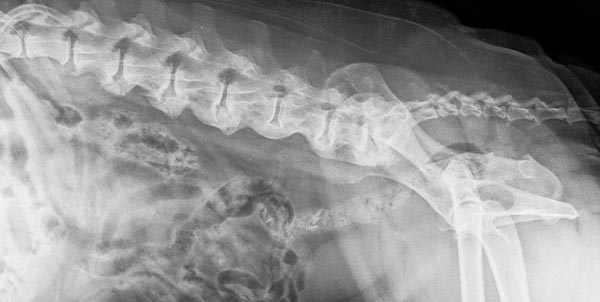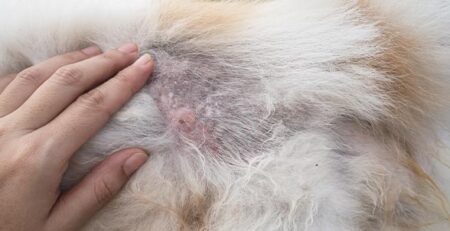Spondylosis in dogs is a degenerative disease that affects the spine of large animals, molossoids in particular.
Spondylosis occurs when bony outgrowths form on the lumbosacral vertebrae that tend to enlarge over time, impairing the mobility and elasticity of the four-legged animal’s spine.
These growths are called osteophytes.
Where exactly do osteophytes form?
These bony neoformations can be found in both the thoracic, lumbar, and lumbosacral portions of the dog’s spine.
These bony prominences can expand to almost encircle the vertebra causing compression of the spinal nerves that exit the affected segment resulting in inflammation of the surrounding tissues.
The typical symptomatology of spondylosis
The disease may present with symptoms that vary according to the progression of the pathology and to the painability that follows.
Clinical signs can occur in dogs as early as young age, around one year old, but are more common in adults.
The dog assumes characteristic attitudes that help it relieve the column of body weight and in gaits.
The most recurrent one is to lower the hind end to distribute its weight over the entire column and load on the front legs.
Another typical attitude of the dog with spondylosis is to keep the neck and head strongly tilted downward
Altered posture inevitably affects other parts of the body as well.
Postural deficit causes lameness, knee and foot microtrauma with development of secondary pseudoarthrosis.
The most severe cases of spondylosis
The incidence and size of osteophytes increase with the age of the dog.
In severe cases there is considerable stiffening of the spine and consequently of all four limbs to the point of total immobility.
Typically, the disease affects adult medium-large breeds, particularly molossoids and boxers.
Among the causes of this condition, the genetic component and race predisposition assume particular importance.
Diagnosis and treatment for spondylosis
Diagnosis is confirmed by an X-ray of the spine to which CT scans may be added.
X-rays and CT scans make it possible to identify the vertebrae affected by degenerative processes, locate any lesions, and evaluate possible peripheral nervous system changes.
Treatment involves the administration ofpainkillers to relieve the pain experienced by the dog during movement and reduce inflammation.
However, drug therapy is not enough and must be supported by physiotherapy and a dog’s lifestyle properly managed by his human companions.
So, any sporting activity and consequently jumping, wild running and stairs that are too steep are absolutely forbidden.
If you suspect your dog has spondylosis, a timely appointment with our Orthopedic Veterinarians is essential.
We would like to remind you, in this regard, that at our facility you can submit your dog to a complete check-up and the necessary clinical examinations, taking advantage of the advice of specialized Veterinary Doctors.
And again, in case of need and urgency Clinica La Veterinaria is always open h24 every day including holidays and with First Aid service from 8 pm to 8 am.
For the joy of seeing them HAPPY











